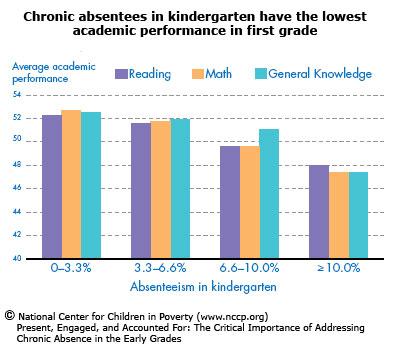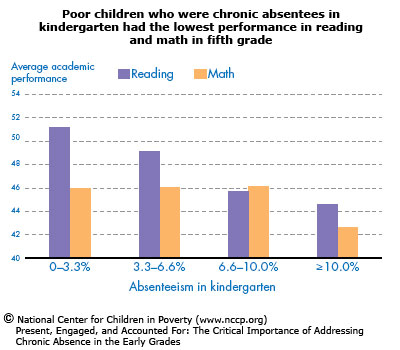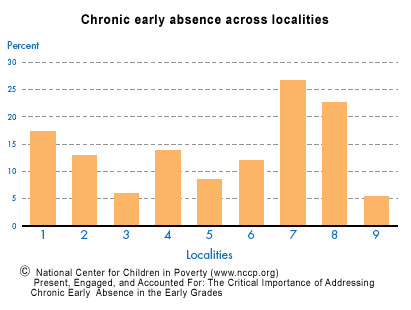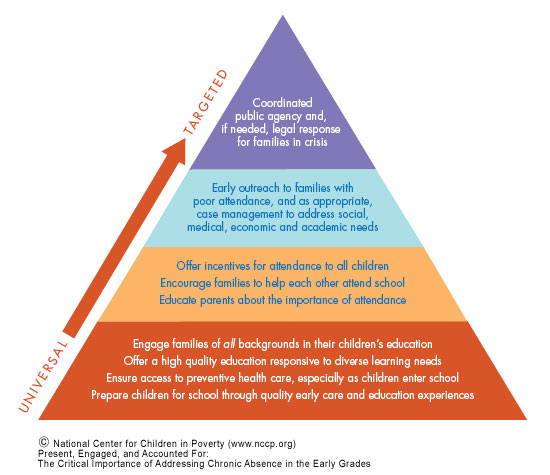Executive Summary
At the core of school improvement and education reform is an assumption so widely understood that it is rarely invoked: students have to be present and engaged in order to learn. That is why the discovery that thousands of our youngest students are at academically at-risk because of extended absences when they first embark upon their school careers is as remarkable as it is consequential. Schools and communities have a choice: we can work together early on to ensure families get their children to class consistently or we can pay later for failing to intervene before problems are more difficult and costly to ameliorate.
Common sense and research suggest that attending school regularly is important to ensuring children develop a strong foundation for subsequent learning. During the early elementary years, children are gaining basic social and academic skills critical to ongoing academic success. Unless students attain these essential skills by third grade, they often require extra help to catch up and are at grave risk of eventually dropping out of school. Moreover, when chronic absence occurs (missing 10% – nearly a month – or more of school over the course of a year counting both excused and unexcused absences), everyone pays. The educational experiences of children who attend school regularly can be diminished when teachers must divert their attention to meet the learning and social needs of children who miss substantial amounts of school.
Chronic absence in the early grades reflects the degree to which schools, communities and families adequately address the needs of young children. Attendance is higher when schools provide a rich, engaging learning experience, have stable, experienced and skilled teachers and actively engage parents in their children’s education. Chronic early absence decreases when educational institutions and communities actively communicate the importance of going to school regularly to all students and their parents, and reach out to families when their children begin to show patterns of excessive absence. Attendance suffers when families are struggling to keep up with the routine of school despite the lack of reliable transportation, working long hours in poorly paid jobs with little flexibility, unstable and unaffordable housing, inadequate health care and escalating community violence. At the same time, communities can help lower chronic absence by providing early childhood experiences that prepare children and families for entry into formal education.
Although chronic early absence can be a significant issue for entire school districts and particular elementary schools, it has largely been overlooked. The United States does not have a mechanism in place to ensure that schools across the country monitor and report on levels of chronic early absence. Elementary schools often track average daily attendance or unexcused absences (truancy), but few monitor the combination of excused and unexcused absence for individual students. High overall school-wide attendance rates can easily mask significant numbers of chronically absent students. While a growing interest in state data systems with universal student identifiers creates an opportunity to collect such data systematically, many districts have yet to develop the capacity for tracking absences for individual students. As a result, many school districts do not know the extent to which chronic early absence is a problem in any or all of their schools.
This applied research project, supported by the Annie E. Casey Foundation, sought to explore the prevalence, consequences, potential contributing factors and possible responses to chronic absence in grades K-3. To deepen understanding of the issue, this project supported new analysis of national and local data on student attendance patterns, a review of relevant literature, and interviews with practitioners, researchers, and funders about promising practices and programs. The National Center for Children in Poverty (NCCP) analyzed national data2 from the Early Childhood Longitudinal Study, Kindergarten Cohort (ECLS-K), to assess impact, prevalence and risk factors for chronic early absence. Annie E. Casey Foundation staff and consultants worked with the Urban Institute, the National Neighborhood Indicators Partnership, the National Center for School Engagement, and Metis Associates to examine early absenteeism patterns in nine, mostly urban, localities by grade and for particular populations. This summary presents our findings about why chronic early absence matters, what contributes to its prevalence, and what are the implications for action.
Why Does Chronic Early Absence Matter?

Chronic early absence matters because it adversely affects academic successes and affects large numbers of children, especially in some communities and schools. NCCP’s national data analysis found that chronic absence in kindergarten is associated with lower academic performance in first grade for all children regardless of gender, ethnicity or socioeconomic status. The relationship is especially strong for Latino children, who had much lower first grade readings scores if they were chronically absent in kindergarten. This relationship appears to reflect the consequences of less time on task. Participation in full-day as opposed to half-day kindergarten seems to lessen the negative impact of chronic absence in kindergarten among poor children. Going to school regularly in the early years is especially critical for children from families living in poverty, who are less likely to have the resources to help children make up for lost time in the classroom. Among poor children, chronic absence in kindergarten predicts the lowest levels of educational achievement at the end of fifth grade.

Chronic early absence affects substantial numbers of children nationwide and is even more problematic in some districts and schools. An estimated one in ten kindergarten and first grade students are chronically absent nationally. Prevalence of chronic early absence varied markedly across the nine localities studied; it ranged from affecting one out of 20 to almost one out of four students enrolled in grades K-3.

Chronic absence can be much higher in particular schools than district-wide. For example, the incidence of chronic early absence ranged from one percent to 54.5 percent across schools in a district where prevalence was 13.8 percent overall.
What Contributes to Chronic Early Absence?
Children’s development and educational outcomes take place in the context of multiple, ongoing influences among children themselves, their immediate environments (family, school, peer group), and the larger environments (neighborhood, community, culture, society at large). When chronic early absence occurs, we must examine the extent to which schools, families and communities each might play a contributing role.
Is chronic early absence an indication that schools…
- do not communicate the importance of attendance to parents in their home language and in culturally appropriate ways?
- do not monitor absences or reach out to families when children miss extended periods of time to identify and where feasible, address barriers to school attendance?
- do not effectively engage parents in their children’s education including inadequately drawing upon family assets and cultural resources to promote academic success?
- do not offer a high quality, engaging and safe educational experience because they are under resourced and suffer from challenges such as limited availability of effective instructional strategies and supports for learning, high rates of staff turnover and teacher absenteeism, and inadequate school facilities?
Is chronic early absence an indication that families…
- are unaware of the adverse impact of chronic early absence and have not yet developed routines that promote consistent school attendance?
- are poor and lack the resources (transportation, food, clothing, social supports, etc) to ensure their children regularly attend school?
- are highly mobile?
- have difficulty addressing and managing illness, especially chronic disease?
- have a history of negative experiences with education n face multiple risks (for example, living in poverty, teen motherhood, single motherhood, low maternal education, welfare, unemployment, food insecurity, poor maternal health and multiple siblings)?
- are dealing with serious problems (for instance, mental illness, homelessness, child or domestic abuse, incarceration of a parent, etc.) that make school attendance difficult because family life has been disrupted and public agencies and schools lack a coordinated response?
Is chronic early absence an indication that communities…
- do not provide adequate support (such as high quality preschool programs) to help young children and families make a positive transition into elementary school?
- are severely distressed and suffer from a dearth of formal or informal supports to promote the positive development of children, including regular school attendance?
- experience high levels of violence that adversely affect family functioning and getting children to school safely?
Since conditions can vary substantially across schools, communities, and families, examining the extent to which any or all of these factors are relevant is critical. While parents are responsible for getting their children to school every day, schools and communities need to recognize and address the barriers and challenges that may inhibit them from doing so, especially when they are living in poverty. Large numbers of chronically absent students could indicate systemic problems that affect the quality of the educational experience and/or the healthy functioning of an entire community.
What are Implications for Action?
Action starts with school districts throughout the United States determining whether and to what extent chronic early absence is a relevant problem in any or all schools. School districts should track attendance for individual students and adopt a common definition of chronic early absence (missing 10% or more of the school year regardless of whether an absence is excused or unexcused) so that comparisons can be made. For some school districts, taking this step may first require developing the capacity to track attendance using a universal student identifier. Additional data collection is especially important for understanding the prevalence of chronic early absence in rural and suburban areas as well as other urban school districts.
If chronic absence levels are significant for particular schools, neighborhoods or populations of students (that is, specific ethnic or language groups or, for example, children in special education), schools should partner with community agencies and families to understand the factors contributing to early absence to develop appropriate responses tailored to their realities. The good news is that the wide variations in levels of chronic early absence across and within districts indicates that the incidence of chronic early absence can be reduced. Available research combined with the experience of pioneering programs, suggest that schools and communities can make a significant difference when they intentionally partner over time to promote attendance through a combination of universal and targeted strategies. The diagram below illustrates what could be encompassed within a comprehensive response. Based upon an assessment of their own strengths and challenges, each school community can identify which strategies need to be put in place to reduce chronic absence.
A comprehensive and intentional approach characterizes the school district that had the lowest level of chronic early absence (5.4 percent) among the nine localities examined. Each school has an attendance team, which makes sure that families are contacted as soon as students miss three days of school. Home visits occur after five days. This district has a strong track record of collaborating with public agencies as well as community-based agencies and is located in one of the few states providing universal preschool education. Over the past four years, chronic early absence fell from 10 percent to 5 percent among young students living in high poverty neighborhoods. In this district, unlike all other localities examined, students from high poverty neighborhoods had better attendance than their peers living in other parts of town.

Paying attention to early absenteeism can be an effective strategy for identifying and addressing educational and familial issues early on. Schools and communities can benefit by embedding attention to chronic early absence in relevant initiatives focused on, for example, school readiness, afterschool programs, school-based health services, and dropout prevention. Monitoring chronic early absence and using it as a trigger for early intervention, could help schools and communities partner with families to ensure every child begins school with an equal opportunity to reach his or her potential.
Endnotes
1. In 2006, the Federal No Child Left Behind began requiring states to define and report on data on truancy; states are not, however, required report on chronic early absence or adopt a uniform definition.
2. For additional information on findings of national data analysis, see A National Portrait of Chronic Absenteeism in the Early Grades, The Influence of Maternal and Family Risk on Chronic Absenteeism in Early Schooling, How Maternal, Family and Cumulative Risk Affect Absenteeism in Early Schooling: Facts for Policymakers, and other publications.
